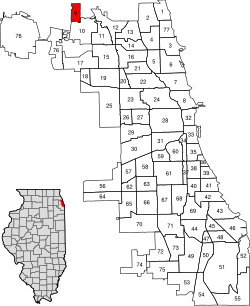
Niles is a village in Cook County, Illinois, United States, located in the townships of Maine and Niles, directly neighboring the City of Chicago's far northwest border. Per the 2020 census, the population was 30,912. The current mayor of Niles is George Alpogianis.
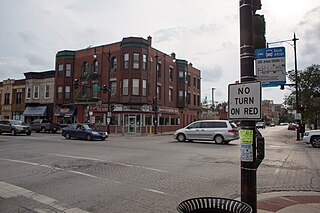
Bridgeport is one of the 77 community areas in Chicago, on the city's South Side, bounded on the north by the South Branch of the Chicago River, on the west by Bubbly Creek, on the south by Pershing Road, and on the east by the Union Pacific railroad tracks. Neighboring communities are Pilsen across the river to the north, McKinley Park to the west, Canaryville to the south, and Armour Square to the east. Bridgeport has been the home of five Chicago mayors. Once known for its racial intolerance, Bridgeport today ranks as one of the city's most diverse neighborhoods.

Norwood Park is one of the 77 Chicago community areas. It encompasses the smaller neighborhoods of Big Oaks, Norwood Park East, Norwood Park West, Old Norwood Park, Oriole Park, and Union Ridge.

Austin is one of 77 community areas in Chicago. Located on the city's West Side, it is the third largest community area by population and the second-largest geographically. Austin's eastern boundary is the Belt Railway located just east of Cicero Avenue. Its northernmost border is the Milwaukee District / West Line. Its southernmost border is at Roosevelt Road from the Belt Railway west to Austin Boulevard. The northernmost portion, north of North Avenue, extends west to Harlem Avenue, abutting Elmwood Park. In addition to Elmwood Park, Austin also borders the suburbs of Cicero and Oak Park.

Archer Heights is a community area in Chicago, Illinois, one of the 77 official community areas of Chicago.
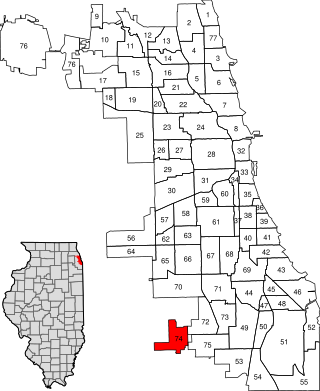
Mount Greenwood is one of the 77 community areas in Chicago. The 74th numbered area, it is about 14 miles (23 km) southwest of the Loop. It is surrounded by the neighborhoods of Beverly and Morgan Park to the east, the suburb of Evergreen Park to the north, the suburb of Oak Lawn to the west, and the suburbs of Merrionette Park and Alsip to the south. Mount Greenwood is known as the home of many Chicago firefighters, Chicago police officers, and union workers.

West Pullman is a neighborhood located on the far south side of the city of Chicago, Illinois. It is one of the 77 official community areas of Chicago. The Neighborhood of West Pullman was largely inhabited by workers of the Pullman Train Company who were looking to escape the grip of the company town Pullman. The commercial corridor of Kensington/115th Street was one of many Italian communities within Chicago.

South Lawndale is a community area on the West Side of Chicago, Illinois. Over 80% of the residents are of Mexican descent and the community is home to the largest foreign-born Mexican population in Chicago.

Avalon Park, located on the south side of the U.S. city of Chicago, Illinois, is one of the city's 77 semi-official community areas and is named after its main park. Its boundaries are 76th St. to the north, South Chicago Ave. to the east and 87th St. to the south. The community area includes the neighborhoods of Avalon Park, Marynook and Stony Island Park.

Burnside is one of the 77 community areas in Chicago. The 47th numbered area, it is located on the city's far south side. This area is also called "The Triangle" by locals, as it is bordered by railroad tracks on every side; the Canadian National Railway on the west, the Union Pacific Railroad on the south and the Norfolk Southern Railway on the east. With a population of 2,254 in 2016, it is the least populous of the community areas, as well as the second smallest by area after Oakland.

Calumet Heights, located on the South Side of the city, is one of the 77 well defined community areas of Chicago, Illinois. Calumet Heights is bounded by 87th Street on the north, South Chicago Avenue on the east, and railroad lines on the west and south.

Roseland is one of the 77 official community areas of Chicago, Illinois, located on the far south side of the city. It includes the neighborhoods of Fernwood, Princeton Park, Lilydale, the southern portion of West Chesterfield, Rosemoor, Sheldon Heights and West Roseland.
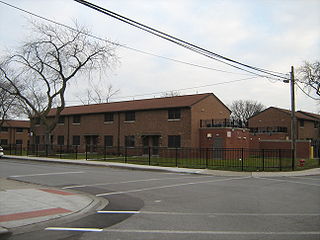
Riverdale is one of the 77 official community areas of Chicago, Illinois and is located on the city's far south side.

Hegewisch is one of the 77 community areas of Chicago, Illinois, located on the city's far south side. It is bordered by the neighborhoods of Riverdale and South Deering to the west, the East Side to the north, the village of Burnham to the south and the city of Hammond, Indiana to the east. The community area is named for Adolph Hegewisch, the president of U.S. Rolling Stock Company who hoped to establish "an ideal workingman's community" when he laid out the town along a rail line in 1883, six years before Chicago annexed the town.
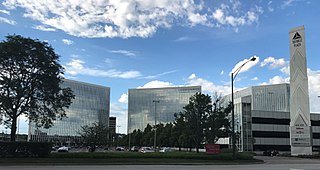
O'Hare, located on the far north side of Chicago, is one of the city's 77 community areas. O'Hare International Airport is located within the boundaries of this community area. This community area is the only one that extends outside Cook County; the western edge is in DuPage County.
Brian G. Doherty was the alderman of the 41st Ward of the City of Chicago from 1991 to 2011. First elected to the Chicago City Council in 1991 when he defeated longtime incumbent Roman Pucinski, Doherty represented portions of the city's Northwest Side, including O'Hare International Airport. In 2010, Doherty won the Republican nomination for Illinois State Senate District 10 to replace retiring Senator James DeLeo (D-Chicago), but he lost the general election to John Mulroe. Doherty did not seek re-election after his defeat in the Senate contest and left office in 2011.

John G. Mulroe is a judge of the Circuit Court of Cook County and lawyer from Chicago, Illinois. Between August 2010 and June 2019, he was a Democratic state senator, representing the 10th Illinois State Senate District. He was appointed to complete the term of Democrat James DeLeo in August 2010 and elected to a full term in the Illinois State Senate in November 2010. He served in the position for nearly nine years before leaving the Illinois Senate in 2019. Robert Martwick replaced Mulroe in the Illinois Senate.
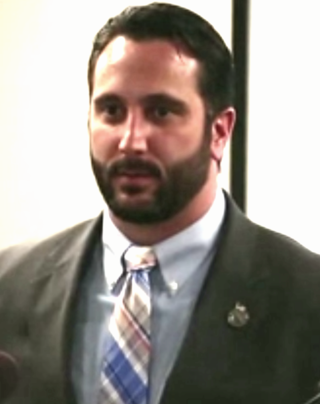
Anthony V. Napolitano is the current Alderman for Chicago's 41st ward, located on the Northwest side and including Edison Park, Norwood Park, Oriole Park, O'Hare and Edgebrook.
Lindsey LaPointe is a Democratic member of the Illinois House of Representatives for the 19th district. The district, located in the Chicago area, includes parts of Elmwood Park, Harwood Heights, Norridge, and River Grove and includes parts of the Chicago neighborhoods of Dunning, Forest Glen, Jefferson Park, Norwood Park, O'Hare, and Portage Park.
Michael Kelly is a Democratic member of the Illinois House of Representatives from the 15th district since his appointment on November 23, 2021. The 15th district, located in the Chicago area, includes parts of Glenview, Morton Grove, Niles, Park Ridge, and Skokie and includes parts of the Chicago neighborhoods of Albany Park, Forest Glen, Irving Park, Jefferson Park, North Park, and Norwood Park.

